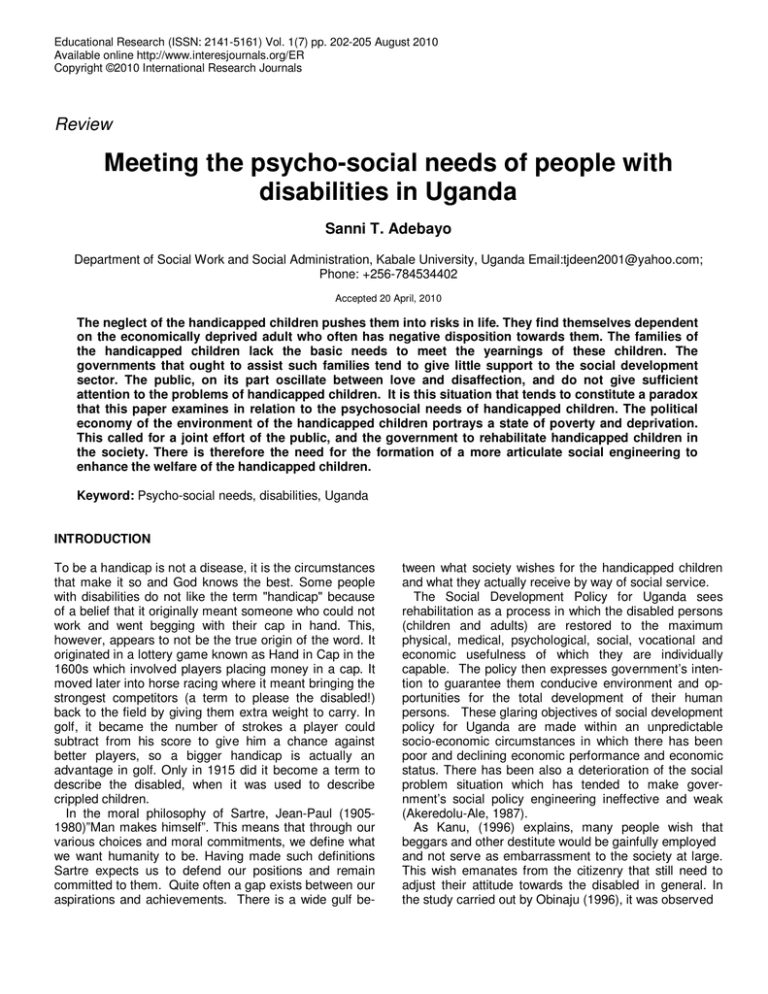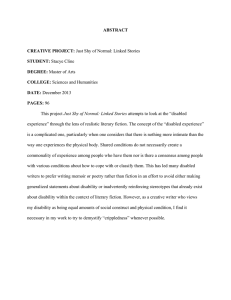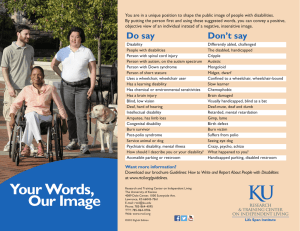Document 14106081
advertisement

Educational Research (ISSN: 2141-5161) Vol. 1(7) pp. 202-205 August 2010 Available online http://www.interesjournals.org/ER Copyright ©2010 International Research Journals Review Meeting the psycho-social needs of people with disabilities in Uganda Sanni T. Adebayo Department of Social Work and Social Administration, Kabale University, Uganda Email:tjdeen2001@yahoo.com; Phone: +256-784534402 Accepted 20 April, 2010 The neglect of the handicapped children pushes them into risks in life. They find themselves dependent on the economically deprived adult who often has negative disposition towards them. The families of the handicapped children lack the basic needs to meet the yearnings of these children. The governments that ought to assist such families tend to give little support to the social development sector. The public, on its part oscillate between love and disaffection, and do not give sufficient attention to the problems of handicapped children. It is this situation that tends to constitute a paradox that this paper examines in relation to the psychosocial needs of handicapped children. The political economy of the environment of the handicapped children portrays a state of poverty and deprivation. This called for a joint effort of the public, and the government to rehabilitate handicapped children in the society. There is therefore the need for the formation of a more articulate social engineering to enhance the welfare of the handicapped children. Keyword: Psycho-social needs, disabilities, Uganda INTRODUCTION To be a handicap is not a disease, it is the circumstances that make it so and God knows the best. Some people with disabilities do not like the term "handicap" because of a belief that it originally meant someone who could not work and went begging with their cap in hand. This, however, appears to not be the true origin of the word. It originated in a lottery game known as Hand in Cap in the 1600s which involved players placing money in a cap. It moved later into horse racing where it meant bringing the strongest competitors (a term to please the disabled!) back to the field by giving them extra weight to carry. In golf, it became the number of strokes a player could subtract from his score to give him a chance against better players, so a bigger handicap is actually an advantage in golf. Only in 1915 did it become a term to describe the disabled, when it was used to describe crippled children. In the moral philosophy of Sartre, Jean-Paul (19051980)”Man makes himself”. This means that through our various choices and moral commitments, we define what we want humanity to be. Having made such definitions Sartre expects us to defend our positions and remain committed to them. Quite often a gap exists between our aspirations and achievements. There is a wide gulf be- tween what society wishes for the handicapped children and what they actually receive by way of social service. The Social Development Policy for Uganda sees rehabilitation as a process in which the disabled persons (children and adults) are restored to the maximum physical, medical, psychological, social, vocational and economic usefulness of which they are individually capable. The policy then expresses government’s intention to guarantee them conducive environment and opportunities for the total development of their human persons. These glaring objectives of social development policy for Uganda are made within an unpredictable socio-economic circumstances in which there has been poor and declining economic performance and economic status. There has been also a deterioration of the social problem situation which has tended to make government’s social policy engineering ineffective and weak (Akeredolu-Ale, 1987). As Kanu, (1996) explains, many people wish that beggars and other destitute would be gainfully employed and not serve as embarrassment to the society at large. This wish emanates from the citizenry that still need to adjust their attitude towards the disabled in general. In the study carried out by Obinaju (1996), it was observed Adebayo 203 that although a positive attitude was shown towards the mentally-retarded/children with learning disability, the degree was not high enough to encourage government to give the child maximum opportunity for development. This is tantamount to saying that the government’ policy measure is often the outcome of the people’s expression and attitude. Yet, people’s attitude towards the exceptional children could affect the actualization of their dream and therefore, make them contribute to national development, (Abang, 1992). The irony of the prevailing situation is that few Ugandan wish that something ought to be done to ameliorate the conditions of these handicapped children (Abosi and Ozoji, 1985). Although current literature tends to suggest a gradual shift in the attitude of people to the disabled generally, much is still expected to be done in order to encourage a more favourable disposition and an enabling environment for further policy formulation and implementation. The paper, therefore, wishes to emphasis the need to improve the human social situation prevailing in Uganda. It is our contention that such an improvement will brighten the conditions of the mental and psychological states of the disabled children. It is a total change in policy making that we advocate. The neglect of the handicapped children should be reduced to a level in which their psychosocial functioning can become less dependent on the general populace. In this regard, a theoretical framework explanations, and socio-economic of the child’s milieu is described. Theoretical Framework The terms disabled and handicapped are used synonymously, (Olumodeji, 1997). According to Onoge (1986), disability is “a physical or mental condition which limits activities or functioning” The World Health Organization (WHO1980) defines disability as “any restriction or lack (resulting from an impairment) of ability to perform an activity in the manner or within the range considered normal for a human being.” Spender and Mitchell, (1971) indicated that handicap is a generic concept. That is considered synonymous with a limiting impairment of bodily form of function, or with a circumstances in the environment that limits or makes a particular activity or function impossible. Thus a missing limb may be a handicap. These definitions stress the loss or impairment of some functions of the human body which could lead to a reduction in personal coping and adaptive functions.Thus, disabled children may be physically handicapped, speech impaired, visually impaired, auditory impaired or mentally retarded and learning disabled. In some cases, there are multiple handicapped. Besides the need for shelter, health and a favourable economic demand for sustenance, there are other psycho-social needs in relation to the psychological and social component of the indivi- dual’s personality and the environment. These needs are expected to guarantee three basic capacities, viz; adaptiveness functionality and optimization (Ibid; 205). Adaptive capacity is the ready adjustment to achieve homestasis or stability in the face of dislocations within and outside the immediate environment. Functional capacity relates to the continuous growth of “physiologic function capacities and appropriate psychologic and social behavior” (Ibid: 205). Optimizing ability is performance that is consistent with personal goals within the limits of social sanctions allowed by the environment. SOCIAL AND ECONOMIC EXPLANATION The social adapted model states although a person’s disability poses some limitations in an able-bodied society, often times the surrounding society and environment are more limiting than the disability itself. The economic model defines disability by a person’s inability to participate in work. It also assesses the degree to which impairment affects an individual’s productivity and the economic consequences for the individual, employer and the state. Such consequences include loss of earnings for and payment for assistance by the individual; lower profit margins for the employer; and state welfare payments. This model is directly related to the charity/tragedy model.The economic model is used primarily by policy makers to assess distribution of benefits to those who are unable to participate fully in work. The challenge facing the economic model is how to justify and support, in purely economic terms, a socially desirable policy of increasing participation in employment. Classical economic laws of supply and demand stipulate that an increase in the labor market results in decreased wages. Arguably, extending access to work through equal opportunities reduces an employer’s labor costs, but other factors come into play. The value of labor is based upon its contribution to marginal cost, i.e. the cost of producing the last unit of production. This only works when employees make an equal contribution to marginal cost. However, evidence suggests that disabled employees make a lower contribution than their work colleagues do, resulting in losses in production and lower profits for the employer. Employers may recognize compensations for any loss in employing less-productive disabled employees through kudos, publicity, customer alignment and expansion arising from their presentations as an organization with community values. However, employers are not generally altruistic and hold the economic viability and operational effectiveness of their organization as higher priorities than demonstrating social awareness. Their economic option is to pay disabled employees less or have the losses met through subsidy. The problem for the users of economic model is one of choice. Which is better: to pay the disabled employee for loss of earnings, or the 204 Educ. Res. employer for loss of productivity? The first carries stigma for the disabled person by underlining their inability to match the performance of work colleagues. With the latter, difficulties arise in correctly assessing the correct level of subsidy. The productivity of a disabled employee may well change, as well as the marginal costs of the total workforce. This leaves one outstanding difficulty for the socially minded economist. How do we achieve an equitable, effective, value-for-money distribution of disability related benefits? It is likely that there will be people with disabilities that prevent them from working. There will be others whose productivity levels are so low that the tax benefits to the public purse are outweighed by the employment subsidy. In economic terms, these people are unemployable and should be removed from employment to supplementary benefits, saving the expenditure on the subsidy. But is this socially acceptable? This apparent conflict has created ambiguity in agreeing on social security goals and has led to stigmatization of disabled people as a burden on public funds rather than partners in the creation of general social prosperity.Social security benefits are not designed to remove disabled people from poverty. The policy maker needs to balance equity (the right of the individual to self-fulfillment and social participation through work) and efficiency. The true value of the economic model is maintaining this balance in the macroeconomic context of trade cycles, inflation, globalization and extraordinary events such as wars. The empowering model allows for the person with a disability and his/her family to decide the course of their treatment and what services they wish to benefit from. This, in turn, turns the professional into a service provider whose role is to offer guidance and carry out the client’s decisions. In other words, this model “empowers” the individual to pursue his/her own goals. The market model of disability is minority rights and consumerist model of disability that recognizing people with disabilities and their stakeholders as representing a large group of consumers, employees and voters. This model looks to personal identity to define disability and empowers people to chart their own destiny in everyday life, with a particular focus on economic empowerment. By this model, based on US Census data, there are 1.2 billion people in the world who consider themselves to have a disability. An additional two billion people are considered stakeholders in disability (family/friends/employers), and when combined with the number of people without disabilities, represents 53% of the population. The Care of Handicapped Children The state of affairs painted here shows how strenuous the condition would be for children, particularly, handicapped children. By the nature of their disabilities they will be at disadvantage when compared with other child- ren. This is why we have earlier indicated that they have some psychosocial needs to be met. Within the ambits of social work, psychosocial is a form of therapy which has some values inherent in it. One of the values is the recognition of the importance and worth of each individual person. This necessitates meeting the need of the individual materially and emotionally, and assist him or her to reach the peak of human capacibility. This value requires that the person concerned should be accorded the right to participate in shaping his or her destiny. Moreover, the ideas of acceptance, non-judgmental attitude, respect, and confidentiality which the person must receive from others, or from the significant others. Within this sphere, disabled children should be assisted to grow and derive emotional stability in themselves and in others around them. We accept the view of Idowu, (1996) that a negative attitude towards a disability can be “more disabling than the disability itself’. Because people of disability are member of the same society.As education is being provided for the disabled children, there is need for people to give them the psychological support to make life enjoyable to them. The disabled children require enormous attention and care from their parent’s right from childhood. As human beings, the parents could become discouraged if they do not observe a positive improvement in the disability. When they have reached the limit of their perseverance, they could feel like giving up. The family needs the support of the community members. The proverbial saying that we are our brother’s keeper requires us to put this in practice. For a disabled child, the rigours of the parent may be too unpleasant to be narrated. But any assistance they receive from the community will go a long way to strengthen them. Social Work has tended to be relegated to the background in the country. For a long time, the government of Uganda accorded the profession a low priority rating and did not offer a coherent operationalisation of the concept. At this period, it is not unlikely that government funding of Social work Programmes, especially those related to the welfare of handicapped children, will be reducing. The rehabilitation centers in many parts of the country lack the material support needed to make them functional and creative. Some of the crafts produced by the disabled children are not easily disposed off in view of the high costs, since little or no subsidies come from government for the production. Non-governmental organizations that have ventured into this field, find it difficult to operate because of lack of funds and materials. They often look outside the confines of the country for sponsorship. Political aspirants and some NGOs as the immediate returns from their largesse’s are not commensurate with their aspirations and promises. The cripples, the amputees, the paralytics who are physically impaired and other handicapped children deserve greater attention and a more positive attitude towards them. Effective process of rehabilitation should be con- Adebayo 205 sidered a joint enterprise between the family and the community. Social Workers and other professionals need to devote more time to the study of handicapped children. A new area of study like that is in vogue in the USA (Davis, 1977). We need to sensitize the general public to form disability movement which will help to transform the policies that will bring about effective, full economic and social integration of disabled people (Oliver and Campbell, 1996). CONCLUSION This paper has attempted to sensitize government and the public to the need to accord the children with disability the necessary attention. The ministry of Culture and Community development must see its role as helping to bring about nothing less than transformation of society. Responsibility for social welfare rests primarily with the Ministry of Culture and Community Development, but voluntary agencies play an ancillary role. The Ministry sponsors community development self-help projects, which are intended to involve the population in development schemes and to raise the standard of living. A social security system which was introduced in 1967 and amended in 1985.This program provides old-age and disability pensions for employees of firms with five or more workers. Work injury benefits are provided for all workers and are funded by the employer. Therefore, there is still much need attention in there of children with disability. The problems of meeting the psychosocial needs of the children with disability in the future require a rethink on the part of government and the voluntary organization. To mobilize the populace, the government must demonstrate that it has itself been mobilized and conscientised into moving the society towards handling the welfare of children with disability seriousness and devotion. We must make the right choices about the welfare of the children of disability and demonstrate in positive social action that we can be committed to goals and objectives. It cannot be doubted that “man makes himself. We must salvage the ravaged society. REFERENCES Abang T (1992). Handbook of Special Education for Educators in Developing Countries.Jos. Abosi OC, Ozoji ED (1985) Educating the Blind: a descriptive Approach, Ibadan Spectrum Books Ltd. David J (2001). An Introduction to Disability Studies, 2nd edition. Davis LJ (1997). The Disabilities Studies Reader, London, Routledge. North-Central State, Nigeria (1975) Report To the Ministry of Social Development of North-Central State, Kaduna. DePoy E, Gilson SF (2004). Rethinking disability: Principles for professional and social change. Pacific Grove, CA: Wadsworth. Frank B (1978) Handicapping America: Barriers to disabled people. Harper and Row Glenn E (1997). African American Women with Disabilities: An Overview. Kanu S (1996). Continuity Educational Programme As a Rehabilitative Service To the learning disabled: A Case Study of Ibadan Continuing Education Centre (RES)” in Adedoja, T.A. (1996). Family, School Community and Government Involvement in Rehabilitation of the Handicapped, Oyo, SPED. Nikora L, Karapu R, Hickey H, Awekotuku N (2004). Disabled Maori and Disability Support Options. Obinaju QI (1996) .Society’s Attitude Towards the Mentally Retarded/Learning Child: Need for Attitude Change” in Nwazuoke, I.A. and Kolo,I.A. (eds),Exceptional Persons in the Community, National Council for Exceptional Children, Ibadan. Oliver M, Campbell J (1996) Disability Politics: Understanding our Past, Changing our .Future. London Roteledge







